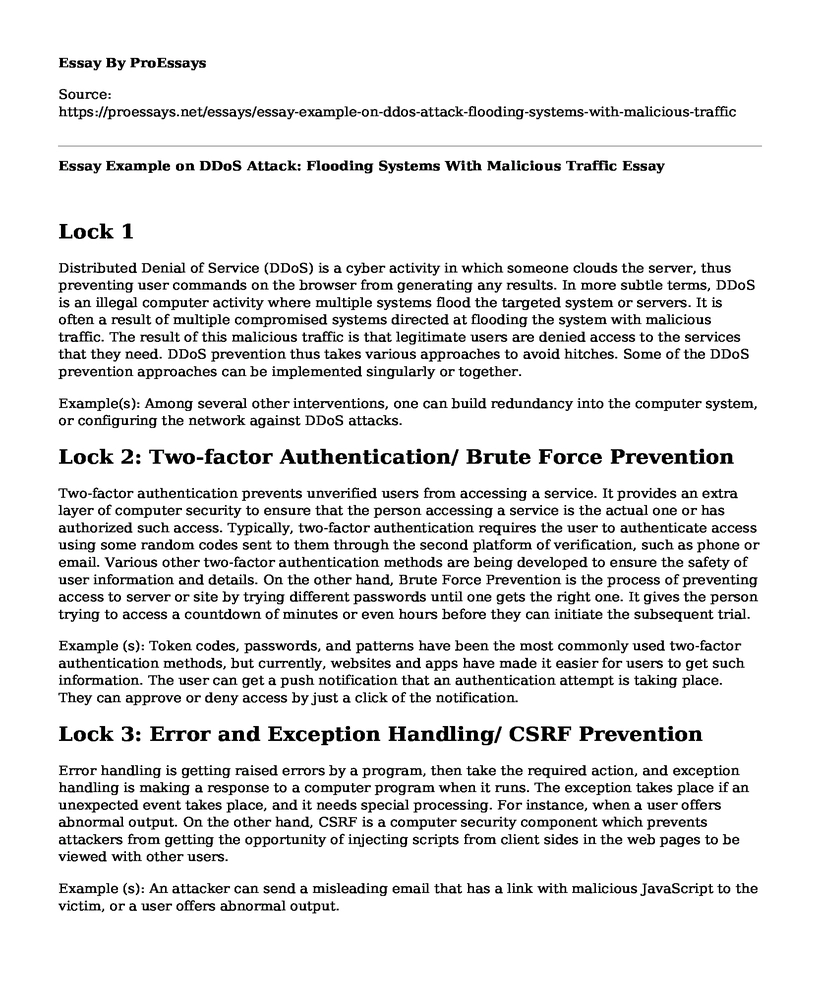Lock 1
Distributed Denial of Service (DDoS) is a cyber activity in which someone clouds the server, thus preventing user commands on the browser from generating any results. In more subtle terms, DDoS is an illegal computer activity where multiple systems flood the targeted system or servers. It is often a result of multiple compromised systems directed at flooding the system with malicious traffic. The result of this malicious traffic is that legitimate users are denied access to the services that they need. DDoS prevention thus takes various approaches to avoid hitches. Some of the DDoS prevention approaches can be implemented singularly or together.
Example(s): Among several other interventions, one can build redundancy into the computer system, or configuring the network against DDoS attacks.
Lock 2: Two-factor Authentication/ Brute Force Prevention
Two-factor authentication prevents unverified users from accessing a service. It provides an extra layer of computer security to ensure that the person accessing a service is the actual one or has authorized such access. Typically, two-factor authentication requires the user to authenticate access using some random codes sent to them through the second platform of verification, such as phone or email. Various other two-factor authentication methods are being developed to ensure the safety of user information and details. On the other hand, Brute Force Prevention is the process of preventing access to server or site by trying different passwords until one gets the right one. It gives the person trying to access a countdown of minutes or even hours before they can initiate the subsequent trial.
Example (s): Token codes, passwords, and patterns have been the most commonly used two-factor authentication methods, but currently, websites and apps have made it easier for users to get such information. The user can get a push notification that an authentication attempt is taking place. They can approve or deny access by just a click of the notification.
Lock 3: Error and Exception Handling/ CSRF Prevention
Error handling is getting raised errors by a program, then take the required action, and exception handling is making a response to a computer program when it runs. The exception takes place if an unexpected event takes place, and it needs special processing. For instance, when a user offers abnormal output. On the other hand, CSRF is a computer security component which prevents attackers from getting the opportunity of injecting scripts from client sides in the web pages to be viewed with other users.
Example (s): An attacker can send a misleading email that has a link with malicious JavaScript to the victim, or a user offers abnormal output.
Lock 4: Digital Certificate
A Digital Certificate electronic password allows an organization or individual to exchange data in a secure manner using critical public infrastructure on the internet. It is the Certification Authority that provides the certificates. The primary certification authorities are Entrust and Verisign.
Example(s): There are three types of digital certificates, including Secure Socket Layer Certificate [SSL], Software Signing [Code Signing Certificate], and Client Certificate [Digital ID].
Lock 5: XSS Prevention
Cross-site scripting is a computer security vulnerability in web applications, its attacks give the attackers the opportunity of injecting scripts from client sides in the web pages, and they can be viewed with other users. For instance, an attacker can send a misleading email that has a link with malicious JavaScript to the victim.
Example (s): Web security filtering can be used to prevent XSS attacks. It validates user-entered parameters.
Cite this page
Essay Example on DDoS Attack: Flooding Systems With Malicious Traffic. (2023, Apr 24). Retrieved from https://proessays.net/essays/essay-example-on-ddos-attack-flooding-systems-with-malicious-traffic
If you are the original author of this essay and no longer wish to have it published on the ProEssays website, please click below to request its removal:
- Retributive Justice Essay Example
- Paper Example on Styles of Policing
- Essay Sample on Supply Network Strategies
- Hustler Magazine v. Falwell: Supreme Court Ruling in Favor of Magazine - Case Study
- Essay Example on Cybercrime: A Growing Threat to Our Digital World
- OWASP Top 10 Web Security Vulnerabilities of 2017 - Essay Sample
- Black Lives Matter Social Movement - Free Essay Sample







